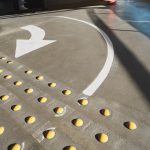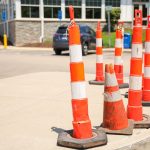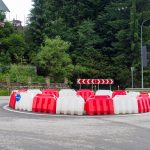Safe Parking Solutions: Transforming Lots with Effective Speed Reducers
Parking lots are often bustling hubs of activity, filled with vehicles maneuvering in various directions. In such environments, ensuring safety is paramount to prevent accidents and promote smooth traffic flow. One indispensable tool for achieving this goal is the strategic placement of speed reducers. These effective traffic calming devices not only help control vehicle speeds but also enhance overall safety for pedestrians and drivers alike.
At Unimat Traffic, we understand the importance of providing reliable solutions for parking lot safety. That’s why we offer a diverse range of high-quality speed reducers designed to meet the unique needs of parking facilities across the USA. Our speed reducers are engineered with durability, effectiveness, and ease of installation in mind, making them the perfect choice for enhancing safety in parking lots of all sizes.
Why Choose Our Speed Reducers for Parking Lots?
- Enhanced Safety: Our speed reducers are meticulously designed to slow down vehicles to safe speeds, reducing the risk of accidents and ensuring a secure environment for pedestrians and drivers.
- Durable Construction: Crafted from premium materials such as rubber, our speed reducers are built to withstand heavy traffic and harsh weather conditions, ensuring long-lasting performance and reliability.
- Easy Installation: With simple installation procedures and user-friendly designs, our speed reducers can be quickly and efficiently installed in parking lots without causing disruption to daily operations.
- Optimal Visibility: Featuring high-visibility colors and reflective markings, our speed reducers enhance visibility, especially in low-light conditions, alerting drivers to reduce speed and navigate safely.
- Versatile Solutions: Whether you’re managing a retail parking lot, office complex, or residential garage, our speed reducers offer versatile solutions tailored to your specific requirements, promoting safety and efficiency.
Buy speed reducers
Investing in effective speed reducers is essential for creating safer parking environments and preventing accidents. At Unimat Traffic, we are committed to providing top-quality solutions that enhance safety and streamline traffic flow in parking lots nationwide. Explore our selection of speed reducers for sale and take the first step towards transforming your parking facility into a safer space for all.
For inquiries or assistance, don’t hesitate to reach out to our team. Let’s work together to make parking lots safer and more secure for everyone.
Related posts:

Choosing the Right Material for Speed Bumps and Humps

Why Speed Bumps are Essential for Parking Lot Safety

Boyas metálicas la solución perfecta para delimitar carriles en obras viales

Cómo instalar bolardos de manera eficiente y segura

The Use of Rubber in Speed Bumps: Why it is the Material of Choice

Road Humps. Best Road Speed bumps

The Cultural Approach to Speed Bumps: A Global Perspective

Right Traffic Calming Measures

Implementing and Accepting Speed Bumps in Different Societies

The Impact of Speed Reducers on Road Safety

Enhancing Road Safety and Cable Protection: The Importance of Resilient Speed Humps

Effective Ways to Implement Speed bumps on Busy Streets
